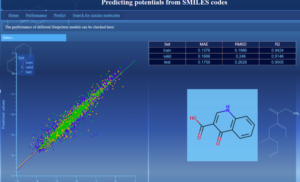One of the major goals of the CompBat project is to elaborate a high-throughput screening (HTS) methodology to assist the discovery of new redox active compounds for aqueous organic redox flow batteries. Towards this end, the TTK team is now expanding the initial molecular database of pyridinium derivatives in various directions. The aim is to increase the structural diversity of the molecules, and also to include compounds of recent electrochemical interest (e.g. viologen derivatives). The current database now includes about 10.000 new molecules, which were compiled from open access databases.
The research team has gained considerable experience in the application of machine learning approaches for the estimation of redox potentials of organic molecules. Deep learning models were found to be particularly efficient for potential predictions for molecules outside of the database, and these methods will represent an important ingredient of the developed HTS methodology.
The TTK team is also involved in the development of web applications that facilitate the data analysis, as well as the utilization of deep learning methods. The Histplotly Python utility was found to be very useful in the interpretation of the trends obtained for the computed reduction potentials. The preliminary version of the app that enables reduction potential predictions for arbitrarily chosen molecules is being tested in the group and by other project members as well. The first feedbacks are quite encouraging, but further improvements are needed prior to publication. Further extension of the database with the inclusion of larger molecules, particularly those with extended π-conjugation, will be necessary to provide a tool of general interest.

Figure: Screenshot from the potential-prediction web app.
